Finding competitor keywords is essential to building your SEO strategy.
Why?
Because they show what’s working for others, highlight opportunities, and uncover gaps in your approach.
At Backlinko, we’ve spied on Ahrefs, Moz, and Semrush’s keywords for years—and found many opportunities.
For instance, Ahrefs gets an estimated 2.5k monthly organic visits from the keyword “website authority checker.”

But this is only part of the story.
The page targets over 1.7k keywords and drives an estimated 30k monthly organic visits.

Clearly, A LOT of people are interested.
So we published a free tool with a supporting blog post on the same topic. Now this page ranks for 1,000 queries and gets over 13k clicks a month from Google.

That’s the power of finding competitor keywords.
In this guide, you’ll learn:
- What competitor keywords are and how they fit into an SEO strategy
- How to find and analyze these keywords, step-by-step
- Where to integrate them into your content and SEO plans
The Power of Using Competitor’s Keywords for SEO
When you find competitors’ keywords, you uncover what content they’re ranking for.
But it’s more than just ranking for a specific keyword.
Think bigger: You’re getting a snapshot of your competitors’ SEO strategy.

Competitor keywords reveal opportunities to boost your SEO in three ways.
First, spotting patterns in your competitor’s keyword strategy and capitalize on gaps.
Say a competitor is going after terms like “best vegan protein powder.” But they might be ignoring budget-conscious customers.
That’s your chance to swoop in and target keywords like “affordable vegan protein powder.”
The goal?
Position yourself to win over the segments they’re missing. Whether it’s budget-friendly options, niche markets, or untapped audiences.
Second, understanding their focus.
Whether they’re targeting broad, high-traffic terms or niche, long-tail keywords.
Say a competitor is focused on targeting top-funnel keywords like “online course platforms.”
Here, you can take a different route.
Why not target bottom-funnel queries like “how to create an online course for free?”
It will help you reach an audience ready to buy.
Third, building a content plan based on your strategy.
Finding competitors’ keywords gives you ideas for a content calendar.
Use them to plan your next topics, decide on content formats. And, finally, create content that meets your audience’s needs better than anyone else.
Now, you’ll learn techniques to find competitors’ keywords.
Step 1: Identify Your SEO Competitors
If you want to find competitors’ keywords, focus on SEO competitors.
These are websites competing with you for similar keywords and rankings.
They may not even be direct business competitors.
Start with a manual search and analysis.
Imagine your business is in the crypto space.
Think of relevant keywords that your potential customers might use.
Like “best crypto platforms 2024.”
Search the keyword on Google.

Take note of the websites that rank for this keyword.
In our example: Investopedia, Alchemy, and NerdWallet.
These are your content competitors.
Next, check the “People also ask” box.

It’s a good tool for finding additional keywords and content ideas.
Now, let’s explore another method for finding competitors.
First, create a free Semrush account and follow these steps:
Head to the Organic Research tool.
Add your URL and hit “Search.”

Then, scroll down to “Main Organic Competitors.”
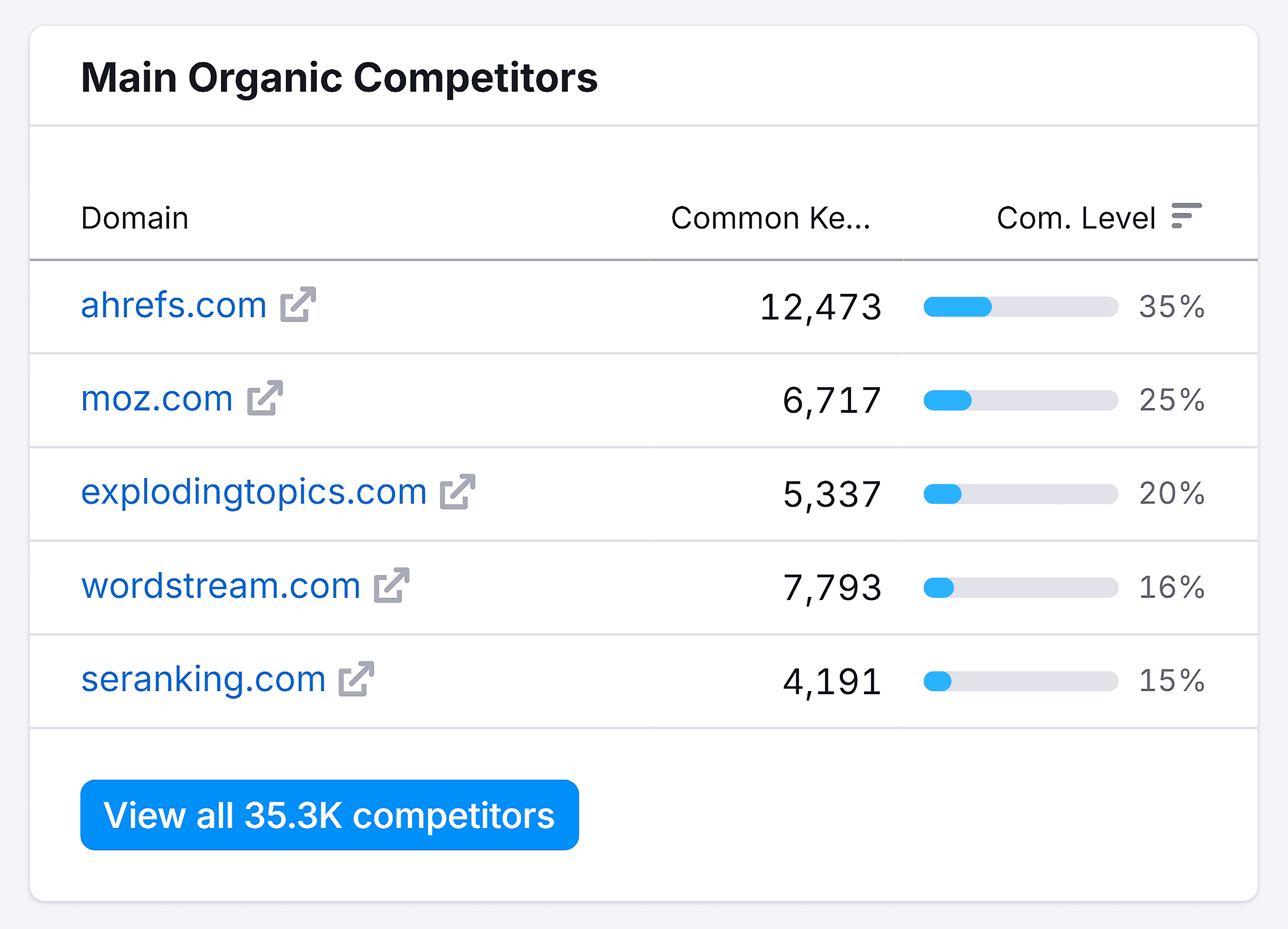
Click the “View all 35.3K competitors” button to show your rivals.

Now, locate the “Com. Level” column.
You’ll see a percentage showing keyword alignment with your competitor.
For Backlinko, Ahrefs has a 35% competitive overlap, and Moz has 25% overlap.
Both are close content competitors.
Now that you’ve identified your competitors, it’s time to analyze their keywords.
Step 2: Find Competitor Keywords Using Tools
By examining the keywords your competitors rank for, you can uncover opportunities to improve your SEO strategy.
This step will help you find the exact terms your competitors are targeting and how you can potentially outrank them.
We’ll continue with our Backlinko example.
Since we identified Moz as a competitor, let’s enter its URL into the Organic Research tool.
Click “Search.”

In the “Overview” section, you’ll immediately see key data such as the total keywords Moz ranks for, their traffic volume, and the estimated cost of that traffic.

Click the “Positions” tab to view a detailed list.
Here, you’ll find important data:
- “Keyword positions” for each term
- “Intent” showing the user’s goal behind searched query
- “Traffic” generated from these keywords
- “Keyword volume” (searches per month)
- “Keyword difficulty (KD%)” telling you how competitive each keyword is

You can use this information to identify high-value keywords your competitor is targeting and analyze their performance.
How?
Look for keywords with high search volume but lower keyword difficulty.
Use filters to narrow your search and focus on the most promising keywords:
- Set the position filter to “Top 10”: Focus on keywords where your competitors rank high but you don’t
- Adjust the volume filter to “101-1,000 searches per month”: Target keywords with moderate volume so you actually drive organic traffic to your website
- Set keyword difficulty (KD%) to “Possible”: Target keywords where you can rank without having to go all-in on building external backlinks

These filters help you pinpoint keywords that offer a good balance of traffic potential and achievable competition.
For example, a keyword like “seo terms” gets 1K searches per month. And has a KD% of 46.
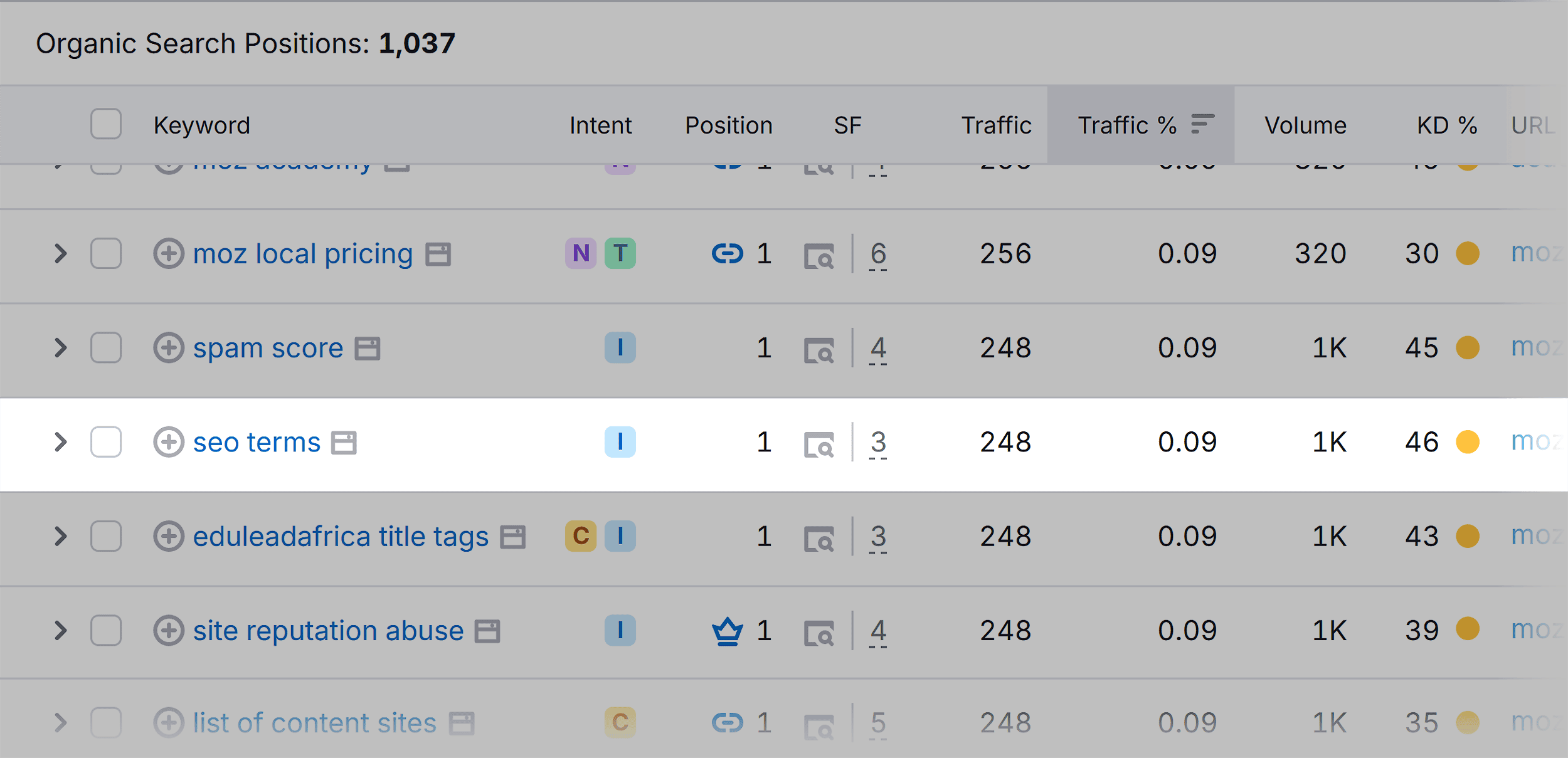
Not bad.
Create better content and optimize it to close gaps and outrank your competition.
Pro tip: Don’t stop at organic keywords—check what terms your competitors are paying for, too. Using tools like Semrush’s Advertising Research, you can uncover the keywords they’re investing in. These paid keywords signal strong opportunities for your SEO campaign.
Step 3: Expand Your Keyword List Through Research
Nuanced research helps you better target and prioritize audience-focused keywords.
In the end, it helps you expand your keyword database in ways that align with your overall strategy.
Let’s explore more advanced techniques to find competitors’ keywords.
Customer Feedback Analysis
Customer feedback is one of the most underrated sources of keyword inspiration.
Customers often use natural terms not found in keyword tools.
By diving into reviews, you can discover keywords that reflect real customer needs.
Let’s say you’re competing with a project management tool like Monday.
Analyze customer reviews on platforms like G2, Trustpilot, or even Google Reviews for local businesses.
They might reveal phrases like “Monday.com prevents copying and pasting data without exporting.”

These kinds of comments give you direct insight into the pain points users are facing with competitors’ products.
And they’re a perfect example of long-tail keywords that you can tackle.
For instance, paste “project management software with data import/export” into Google search to see how saturated the space is.

Here, GetApp’s software comparison page ranks organically in the top spot.
Monday’s competitor, Asana, is also present.
This indicates that content creators see value in addressing this specific pain point for users.
If you’re selling project management software with data import and export features, you could create a blog post or comparison page.
These pieces help attract frustrated users seeking better alternatives.
Private Communities
Your competitor’s private communities like Facebook Groups, Slack channels and Discord servers are gold mines for keyword ideas.
Simply watch what people talk about. You’ll discover:
- Questions they ask (that aren’t being answered)
- Problems they face (that you could solve)
- Terms they use naturally (not marketing speak)
For example, let’s say you’re competing with Nike Training Club.
Join a few fitness Facebook groups where their users hang out.
You might spot people asking about:
- “Best bodyweight exercises for beginners”
- “Home workout equipment”
- “Affordable fitness gear”
These terms could be perfect keywords that a competitor isn’t targeting yet.
Here’s what to do next:
Head to Semrush’s Keyword Magic Tool.
Enter your target keyword into the search bar.
Then, hit “Search.”
We’ll use “home workout equipment” as an example.

This generates us a list of relevant keywords.
Next, we’ll set some filters to refine the list.
Adjust the “Volume” filter to 101–1,000, and for “Keyword Difficulty,” choose “Possible.”

This will help you identify high-value terms that have decent traffic potential but aren’t overly competitive.

For example, these keywords stand out as prime content opportunities:
- “compact home gym equipment” (320 searches/month)
- “essential home gym equipment” (320 searches/month)
- “affordable home gym equipment” (260 searches/month)
Why?
They have a solid search volume per month. At the same time, they’re not too competitive.
It means you have chances to rank relatively high on the search engine results page (SERP).
Google Search Operators
Google search operators are a powerful tool to find competitor content and gaps in your strategy.
By using specific search queries, you can reveal the topics your competitors are covering and how well they’re doing it.
Start by typing site:competitor.com followed by a keyword or phrase related to your niche.
In our example, we’ll use the niche of organic beauty products.
Let’s say one of our organic competitors is Our Oily House.
We searched: site:https://www.ouroilyhouse.com/ “natural face moisturizer“
This gives us a list of pages on that competitor’s site that mention or target this keyword.
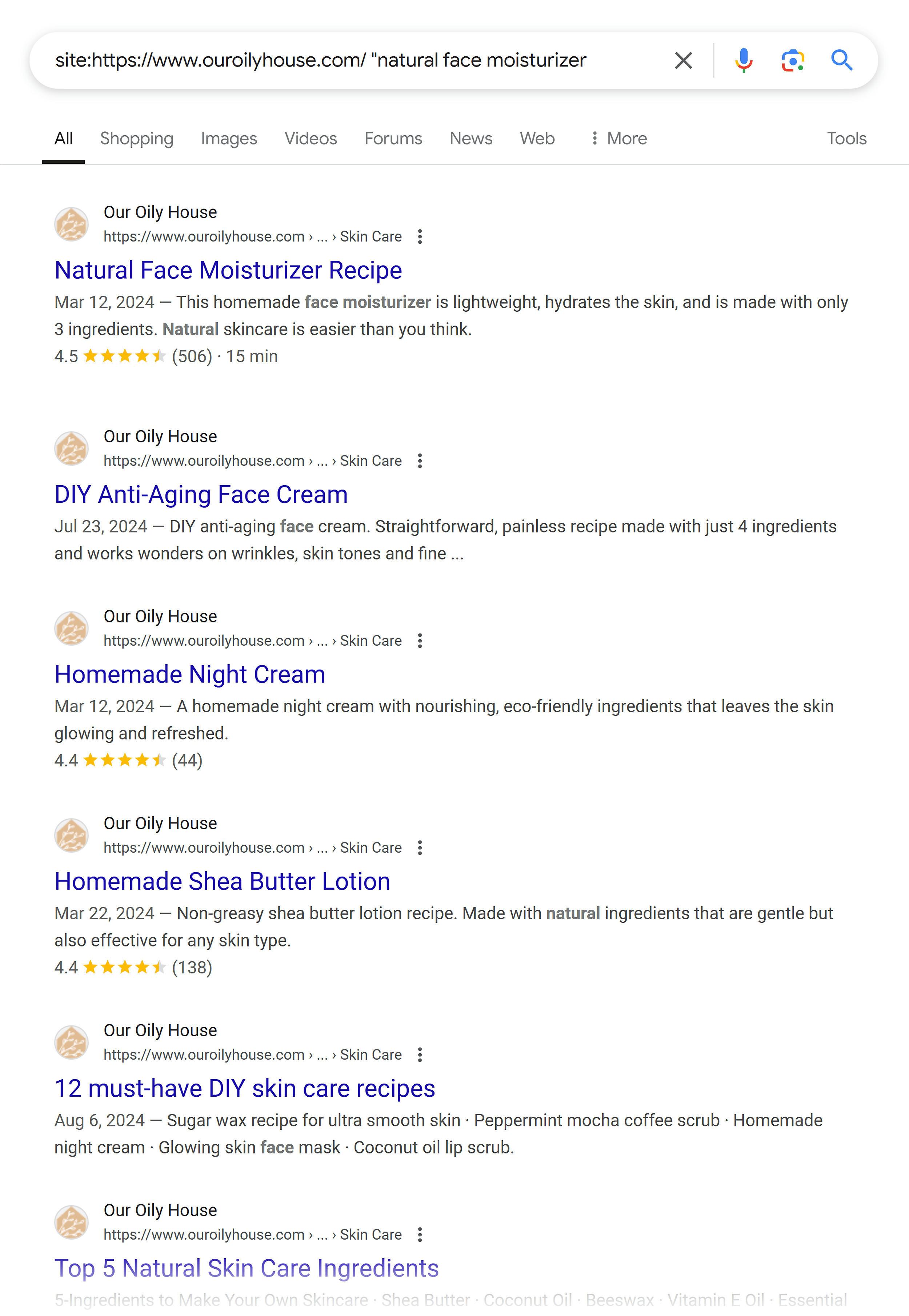
But we don’t stop there.
Now, we’ll look for patterns.
Are they creating topic clusters around natural skincare?
Or organic ingredients?
Or maybe DIY beauty tips?
Examining their content reveals pillar topics and related subtopics they rank for.
For example, we’ll jump back to the Keyword Overview and check “skincare kits.”

It has transactional intent, it gets 1,300 monthly average searches, and the “Keyword Difficulty” is 27.
Great!
Step 4: Evaluate Your Competitors’ Keywords
You know how to find competitors’ keywords.
The next step is to evaluate them.
Analyze competitor keywords to see how intent-based terms target different funnel stages.
Let’s take a keyword like “best online course platforms.”
Now, check the search intent.

It’s “Commercial.”
Meaning users want to investigate and compare brands or services.
This implies a content format that should be a comparison post.
Or a landing page evaluating various platform’s capabilities.
Second, look for keyword relevance.
Focus on competitor keywords that align with your business goals.
These have high keyword relevance.
If your platform offers course creation tools, focus on keywords like “best course software” or “create a membership site.”
For example, broad terms like “passive income from online courses” won’t be useful.
Third, search for volume and difficulty.
Ideally, you’re looking for keywords with high search volume and moderate to low keyword difficulty.
Let’s head back to the Keyword Magic Tool.
We’ll use Teachable as our example.
Enter “best online course platform.”
And add the website URL for personalized results.
Now, hit “Search.”

You’ll see a list of related keywords.
Take a look at the intent, search volume, and personal keyword difficulty (PKD%).
Also, see the position in the SERP.

For example, “best online course platforms” has 480 monthly searches with a PKD% of 0.
Another strong keyword is “best platform to sell online courses,” with 170 searches and a PKD% of 0.
Both are prime targets.
They also have commercial intent.
Meaning searchers are closer to making a purchase decision.
Targeting these can help improve your rankings and capture more organic traffic from competitors.
Step 5: Prioritize Your Competitors’ Keywords List
Now that you’ve analyzed the competitor keywords, the next step is to integrate them into your strategy.
First, compare the competitor keywords with the ones you’re already targeting.
But what exactly are you looking for?
- Are there any high-volume keywords you’re not targeting yet?
- Are there terms they’re ranking for where you could compete?
- Are there areas where you’re already ranking, but could improve?
This will ensure you’re not leaving valuable opportunities on the table.
Earlier, we used the example of vegan supplements.
Here’s a spreadsheet with keyword data for this niche, showing volume, difficulty, and value.
Later, we’ll show you how to create this spreadsheet (and provide a template.)
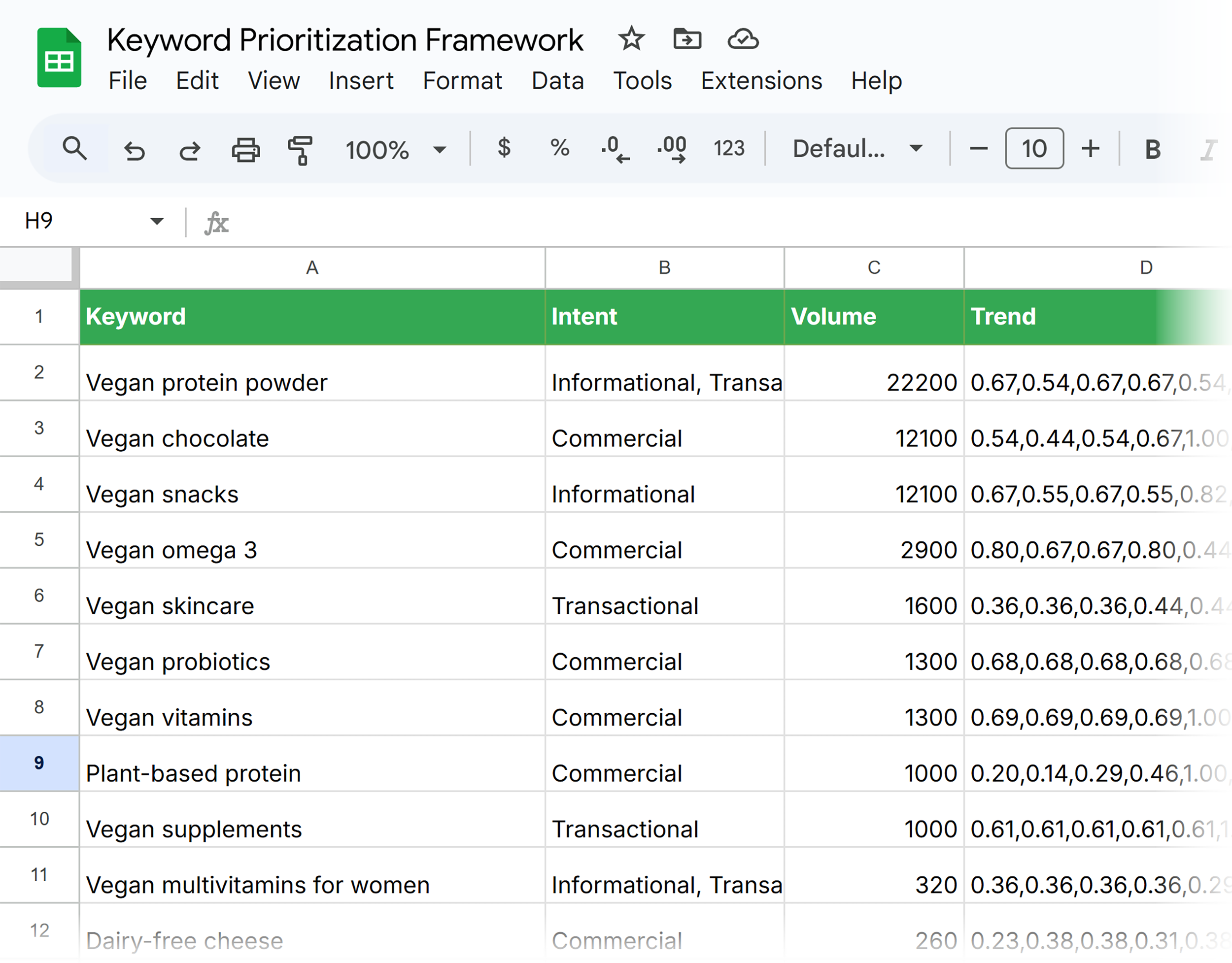
The more keywords you have in your database, the better.
This gives you plenty of options to choose what to write about.
(After all, the better keywords you choose, the faster you can grow your organic traffic and bring more leads.)
Now, go to Keyword Overview, and add all your keywords.
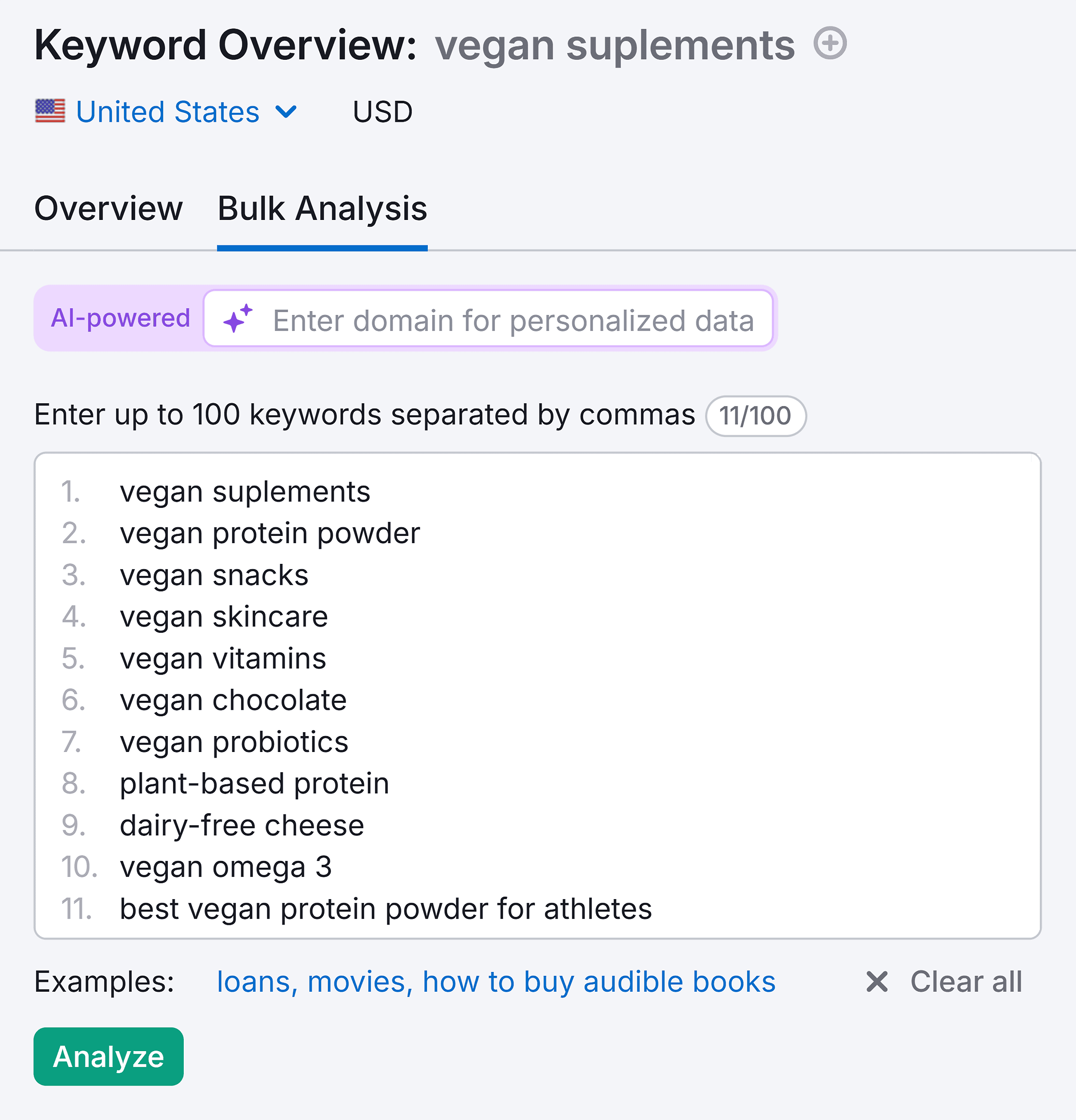
Then, click “Analyze.”
Scroll down and press “Export.”
Choose between XLXS, CSV or CSV semicolon.

To prioritize your keywords well, use a simple scoring framework.
Download the template and follow our steps
We’ll use Google Sheets—we’ve exported our data in CSV format.
Go there and press “Import.”

An “Import file” window will open.
Switch to the tab “Upload,” and choose your exported file.
Then, click “Browse,” and choose your exported file.

Then, click “Import data.”
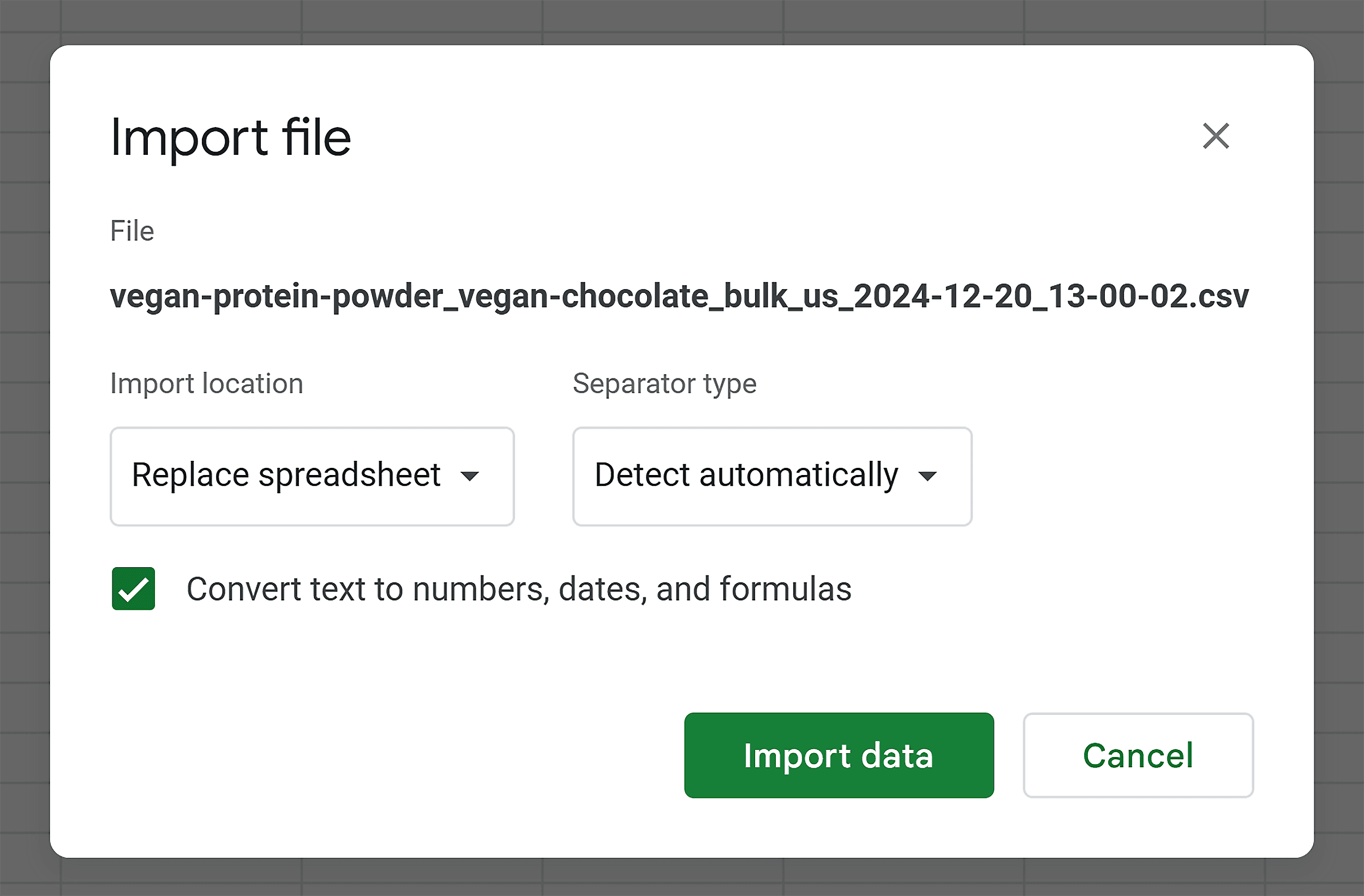
Now, you have your raw data.
What interests you is Volume (column C) and Keyword Difficulty (column E).

Click over to the “Framework” tab and check VLOOKUP formulas.
In our case it’s:
=VLOOKUP(A2, Data_import!$A$1:$G$16, 3, FALSE)to get Search Volume=VLOOKUP(A2, Data_import!$A$1:$G$16, 5, FALSE)to get Ranking Difficulty
At this point, you should have Search Volume and Ranking Difficulty columns and scores for these two (they’re automatic.)

First, let’s talk about Ranking Difficulty.
This tells you how tough it’ll be to rank for a keyword:
- Under 30: Low competition (easy to rank for), score = 1
- 30-60: Medium competition, score = 2
- Over 60: High competition, score = 3
Next, we’ve got Business Value.
This is a manual assessment (you have to insert numbers between 1 and 3 yourself) of how well the keyword aligns with your product or service.
- 3 (High value): If your product fits well into content targeting that keyword
- 2 (Medium value): If your product fits, but not perfectly
- 1 (Low value): If the keyword is barely relevant
Lastly, consider Search Volume.
- Over 800 searches/month: High volume, score = 3
- 500-800 searches/month: Medium volume, score = 2
- Under 500 searches/month: Low volume, score = 1
Once you score all your keywords on these three factors, formulas in the sheet gives you the final score.
This helps you prioritize what to target.
Focus on keywords with high volume, low difficulty, and strong business value.
Here’s how:
- High search volume (over 800 searches per month) means more potential traffic
- Low ranking difficulty (anything under 30) means it’s easier to break into the rankings
- Strong business value means it’s a perfect fit for what you offer, so it’s worth your time to go after it
For example a keyword “vegan protein powder.”
It has high search volume, low ranking difficulty, and business value.
Which means it’s going to be a top priority.
Meanwhile, something like “affordable vegan protein powder” has lower search volume and tougher competition.
So, it might fall to the bottom of the list.
This way, you’re focusing on keywords that’ll actually move the needle.
But remember:
In the end, any framework is just a framework.
Consider market trends, customer feedback, and lifetime value, too.
Now it’s time to create a content plan.
Step 6: Turn Competitor Keywords into Content
Once you’ve integrated competitor keywords into your strategy, it’s time to plan your content around them.
Say you’re a fast-growing brand that can’t compete with big players that rank high for high-volume and high-difficulty keywords.
But you have authority in one field.
And you found loads of decent-volume but low-competition keywords.
So, your strategy should focus on this untapped area.
Suppose your framework lists “vegan vitamins” as a high-priority keyword.

It has commercial intent.
And you know your customers often ask about it.
First, review the types of pages that currently rank for this keyword.
Then, create a landing page that lists all the vegan vitamins.
Ensure it provides more value and depth than competing pages.
Apply this workflow to each of your high-priority keywords for maximum impact.
Get a Strategic Start for Using Your Competitors’ Keywords
Competitor keywords provide valuable insights for a focused SEO strategy.
The most important thing is to approach this task through a strategic lens.
To help you set the right priorities, download our keyword prioritization framework.
Use it to create an at-a-glance reference of your keywords and related data.
Then, put those insights to use to build a better SEO strategy and ultimately outrank your rivals.
Download the template
The post How to Find Competitors’ Keywords to Boost Your SEO appeared first on Backlinko.





